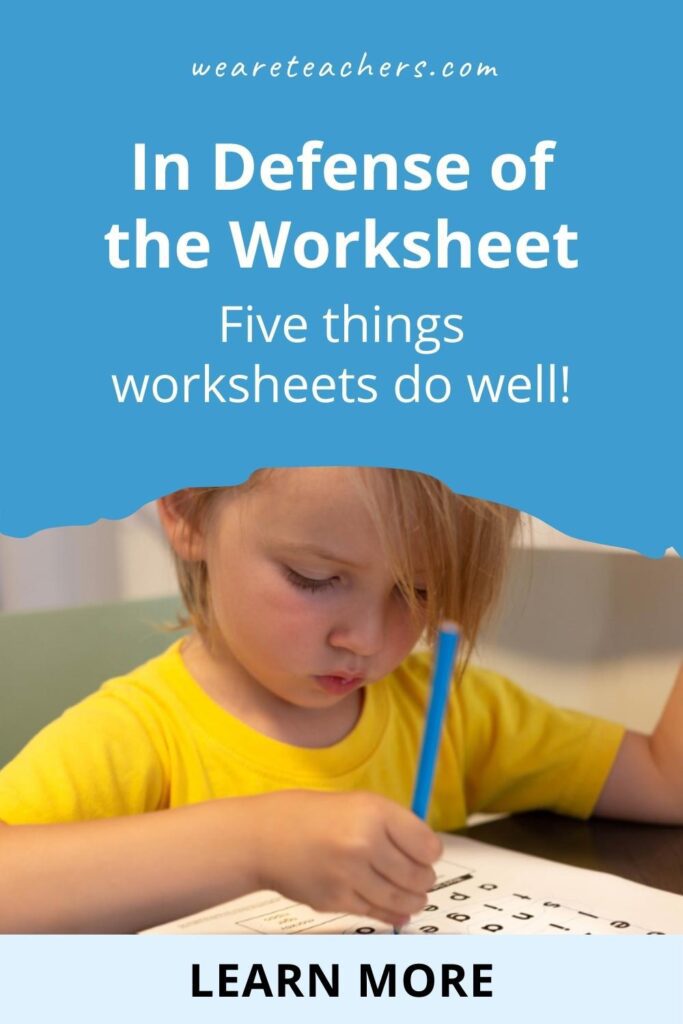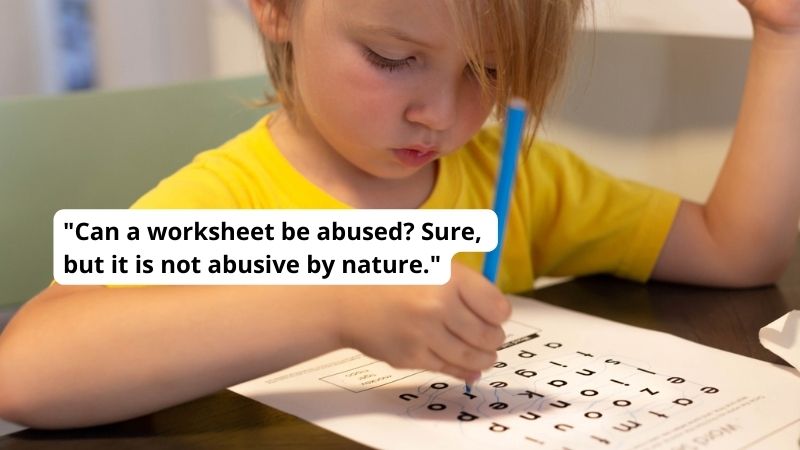There are few more dreaded words in education than “worksheet.” In fact, for many it is synonymous with teacher laziness, student remediation, and even harm. What is it about a sheet of paper with words and blank boxes that ignites such scorn? Why do we get so whipped up about it? Can a worksheet be abused? Sure, but it is not abusive by nature. To the contrary, when used properly, there are very few things that can take a worksheet’s place, particularly for elementary students. I may have to go into a witness protection program for asserting this, but following are five arguments in defense of the worksheet.
1. Worksheets accelerate automaticity.
Your classic worksheet is one of the best tools for getting to automaticity or mastery with foundational skills, which paves the way to more complicated tasks and higher-level thinking. Students’ time spent on worksheets is not dissimilar to the 10,000-hour concept that many are so fond of. Great piano players are the product of many hours of strategic practice. If we were to peer into their world of practice, we would undoubtedly see them working on the same skill over and over and over. Yet, when this concept is applied to learning multiplication or grammar, it is viewed as “drill and kill.” It is much better, as the thinking goes, to have students jump into something hands-on and activity based. What is lost in this assessment is that thinking is also an active process. Writing an answer on a worksheet is simply thinking made visible.
2. Worksheets ease teachers’ workload.
A worksheet is easier to acquire, execute, and review. One of the reasons teachers leave the field is the workload. In education, it has become normal to take five steps when two would do. Why have a student get a blank notebook, fold a page into columns, head the columns, cut out examples from wherever, and have them glue examples onto said page when one worksheet could take care of the bulk of this? Not to mention all the folding and cutting takes away from the lesson’s purpose. People popping into your room may love how this looks, but the time spent giving and re-giving directions would have been better spent sitting with a needy child and her worksheet. Also, worksheets are easier to transport than loads of notebooks.
3. Worksheets leave a clear trail.
Worksheets retain student work better than some other methods. If too many classroom activities rely on discussions and projects, it becomes harder to nail down who is struggling and why. With worksheets, teachers can review them when they have the time to analyze. For students, worksheets often have completed examples for support, which allows them to go back and review as much as needed. Worksheets also provide students with great clarity on their progress, or lack thereof, on a particular skill. This is integral to developing students’ metacognition, confidence, and overall ownership of their learning. All of this might explain why teachers still overwhelmingly use something like a worksheet for tests. This value of transparency is no less important during the time period between tests.
4. Worksheets are fun!
The many students I’ve encountered generally do not have negative reactions when a worksheet comes their way. For the young child, a high-quality worksheet presents a clear, manageable, tightly framed task rather than a formidable one. Students like that they can quickly find out whether an answer is right or wrong, taking on many of the attributes of a fun game. The concept is similar to a Sunday crossword. There is usually only one right answer, and if you find it, a predictable rush of endorphins is your reward. If the questions are sufficiently challenging, the experience summons a true level of engagement for students—the kind that most educators should covet.
5. And finally, worksheets support higher-order work too.
LSATs, MCATs, GREs, and GMATs are all arguably in the family of worksheets. The idea that a task is simplistic because it is pre-written and published is problematic and erroneous. I have been bested by countless paper and pencil tasks and deeply impressed by those who conquered them. Worksheets can contain high-level vocabulary, multi-step problems, open-ended questions, opportunities to synthesize information, and many more rigorous activities. Therefore, the contents of a worksheet should be closely reviewed before a judgement is made about its worthiness.
Just like most things in life, it all depends on execution. When done poorly (excessive use, no feedback, misaligned to objectives, etc.), using worksheets can absolutely be mind-numbing and a sign of poor instruction. Also true: I have seen far more terrible turn-and-talk sessions than bad worksheet use in the last decade, yet I hear no one calling for the end of classroom talk. The heart of this contrast may be tied to the earlier point about a worksheet’s efficiency for boosting foundational skills. Focusing on foundational skills is increasingly viewed as stagnating and oppressive, ergo worksheets are stagnating and oppressive. But any teacher who is serious about the business of teaching and learning knows the consequences of students not mastering prerequisite skills. It is an often devastating scenario that becomes daunting to correct when too much time passes. If you know this, and you know that there are some things that students need to master before they can advance in any meaningful way, go ahead and pull out that worksheet.
Would you go to bat in defense of the worksheet? Please share your thoughts in the comments.
Plus, for more articles like this, be sure to subscribe to our newsletters.


